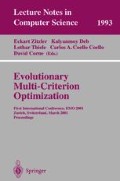Abstract
MOLeCS is a classifier system (CS) which addresses its learning as a multiobjective task. Its aim is to develop an optimal set of rules, optimizing the accuracy and the generality of each rule simultaneously. This is achieved by considering these two goals in the rule fitness. The paper studies four multiobjective strategies that establish a compromise between accuracy and generality in different ways. The results suggest that including the decision maker’s preferences in the search process improves the overall performance of the obtained rule set. The paper also studies a third major objective: covering (the maintenance of a set of different rules solving together the learning problem), through different niching mechanisms. After a performance analysis using some benchmark problems, MOLeCS is applied to a real-world categorization task: the diagnosis of breast cancer.
Access this chapter
Tax calculation will be finalised at checkout
Purchases are for personal use only
Preview
Unable to display preview. Download preview PDF.
References
J.E. Baker. Reducing bias and inefficieny in the selection algorithm. In J.J. Grefenstette, editor, Genetic Algorithms and their Applications: Proceedings of the Second International Conference on Genetic Algorithms, pages 14–21, 1987.
Ester Bernadó Mansilla and Josep Maria Garrell i Guiu. MOLeCS: A MultiObjective Classifier System. In Proceedings of the Genetic and Evolutionary Computation Conference (GECCO), page 390, 2000.
Ester Bernadó Mansilla and Josep Maria Garrell i Guiu. MultiObjective Learning in a Genetic Classifier System (MOLeCS). In Butlletí de l'ACIA, 22. 3r Congrés Català d'Intel.ligència Artificial, 2000.
C.L. Blake and C.J. Merz. UCI Repository of machine learning databases, [http://www.ics.uci.edu/~mlearn/MLRepository.html]. University of California, Irvine, Dept. of Information and Computer Sciences, 1998.
Carlos A. Coello. A Comprehensive Survey of Evolutionary-Based Multiobjective Optimization Techniques. Knowledge and Information Systems. An International Journal, 1(3):269–308, August 1999.
K.A. De Jong. An analysis of the behavior of a class of genetic adaptive systems. (Doctoral Dissertation). PhD thesis, University of Michigan, 1975.
Carlos M. Fonseca and Peter Fleming. An Overview of Evolutionary Algorithms in Multiobjective Optimization. Evolutionary Computation, 3(1):1–16, 1995.
P.W. Frey and D.J. Slate. Letter recognition using Holland-style adaptive classifiers. Machine Learning, 6:161–182, 1991.
David E. Goldberg. Genetic Algorithms in Search, Optimization and Machine Learning. Addison-Wesley Publishing Company, Inc., 1989.
D.E. Goldberg and P. Segrest. Finite Markov chain analysis of Genetic Algorithms. In J.J. Grefenstette, editor, Proceedings of the Second International Conference on Genetic Algorithms, pages 1–8. Lawrence Erlbaum, 1987.
John H. Holland. Escaping Brittleness: The Possibilities of General Purpose Learning Algorithms Applied to Parallel Rule-Based Systems. Machine Learning: An Arti_cial Intelligence Approach, Vol. II, pages 593–623, 1986.
John H. Holmes. Quantitative Methods for Evaluating Learning Classifier System Performance in Forced Two-Choice Decision Tasks. In Second International Workshop on Learning Classifier Systems (IWLCS-99), 1999.
J. Horn, D.E. Goldberg, and K. Deb. Implicit Niching in a Learning Classifier System: Nature’s Way. Evolutionary Computation, 2(1), pages 37–66, 1994.
Tim Kovacs. XCS Classifier System Reliably Evolves Accurate, Complete and Minimal Representations for Boolean Functions. In Roy, Chawdhry and, and Pant, editors, Soft Computing in Engineering Design and Manufacturing, pages 59–68. Springer-Verlag, 1997.
Mahfoud, Samir W. Crowding and preselection revisited. In R. Maenner and B. Manderick, editors, Parallel Problem Solving from Nature, 2, pages 27–36. Elsevier: Amsterdam, 1992.
Mahfoud, Samir W. Niching Methods for Genetic Algorithms. PhD thesis, University of Illinois at Urbana-Champaign, 1995.
Manuel Valenzuela-Rendón and Eduardo Uresti-Charre. A Non-Generational Genetic Algorithm for Multiobjective Optimization. Proceedings of the Seventh International Conference on Genetic Algorithms, pages 658–665, 1997.
David A. Van Veldhuizen. Multiobjective Evolutionary Algorithms: Classifications, Analyses, and New Innovations. PhD thesis, Dept. of Electrical and Computer Engineering. Air Force Institute of Technology,Wright-Patterson AFB, Ohio, 1999.
David A. Van Veldhuizen and Gary B. Lamont. Multiobjective Evolutionary Algorithms: Analyzing the State-of-the-Art. Evolutionary Computation, 8(2):125–174, Summer 2000.
Sholom M. Weiss and Casimir A. Kulikowski. Computer Systems That Learn. Classification and Prediction Methods from Statistics, Neural Nets, Machine Learning and Expert Systems. Morgan Kaufmann, 1991.
Stewart W. Wilson. Classifier Fitness Based on Accuracy. Evolutionary Computation, 3(2):149–175, 1995.
Stewart W. Wilson. Generalization in the XCS Classifier System. In J. Koza et al., editor, Genetic Programming: Proceedings of the Third Annual Conference. San Francisco, CA: Morgan Kaufmann, 1998.
Stewart W. Wilson. Get Real! XCS with Continuous-Valued Inputs. In L. Booker, S. Forrest, Mitchell M., and Riolo R, editors, Festschrift in Honor of John H. Holland. Center for the Study of Complex Systems, University of Michigan, 1999.
Stewart W. Wilson. Mining Oblique Data with XCS. In Third International Workshop on Learning Classifier Systems (IWLCS-2000), 2000.
Author information
Authors and Affiliations
Editor information
Editors and Affiliations
Rights and permissions
Copyright information
© 2001 Springer-Verlag Berlin Heidelberg
About this paper
Cite this paper
Bernadó i Mansilla, E., Garrell i Guiu, J.M. (2001). MOLeCS: Using Multiobjective Evolutionary Algorithms for Learning. In: Zitzler, E., Thiele, L., Deb, K., Coello Coello, C.A., Corne, D. (eds) Evolutionary Multi-Criterion Optimization. EMO 2001. Lecture Notes in Computer Science, vol 1993. Springer, Berlin, Heidelberg. https://doi.org/10.1007/3-540-44719-9_49
Download citation
DOI: https://doi.org/10.1007/3-540-44719-9_49
Published:
Publisher Name: Springer, Berlin, Heidelberg
Print ISBN: 978-3-540-41745-3
Online ISBN: 978-3-540-44719-1
eBook Packages: Springer Book Archive

